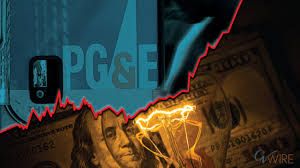Starting from January 1st, PG&E implemented a 13% increase in power charges. This rate hike, estimated to add an extra $33 to the monthly expenses of an average family, aims to fund the burial of power lines and other measures to prevent wildfires.
However, this initial increase is just the tip of the iceberg.

PG&E has submitted the necessary documents to regulatory bodies, proposing an additional $14 monthly increase for the average customer in March. This adjustment is intended to cover the costs of storm repairs and further measures to mitigate the risk of wildfires. Moreover, as indicated in a recent chart presented to shareholders, PG&E plans to pursue even more rate hikes in order to recover the billions it has already invested.
Mark Toney, the head of The Utility Reform Network (TURN), a ratepayer advocacy group, expressed grave concern over the current situation. He emphasized that the utility is facing a severe problem. The utility has fallen behind in terms of rates due to excessive spending on tree cutting and other initiatives aimed at mitigating wildfires from 2020 to 2022. In a report submitted to state regulators, PG&E disclosed that they had exceeded the allocated budget for vegetation management by a staggering $9.3 billion, surpassing the approved $4.7 billion set by the California Public Utilities Commission.
“They overspent $9.3 billion and they expect to collect every penny of it,” Toney said.
Toney anticipates that PG&E will seek an additional $43 per month rate increase, on average, in order to address the previous spending deficit. This would result in a total rate hike of nearly $100 per month by the end of the year. "We're dealing with significant figures that will have a detrimental impact on numerous families who are unprepared for an additional $100 per month," Toney expressed.
However, PG&E's current estimation suggests that rates will only increase by a total of approximately $50 by 2024. This calculation takes into account the January hike, potential approval of pending rate requests by regulators, and the expiration of prior rate increases.
These rate increases coincide with PG&E's plans to distribute dividends to stockholders in 2024, marking the first time since its bankruptcy declaration and reorganization in 2018. Toney and other advocates for ratepayers urge PG&E to ensure that shareholders also contribute towards offsetting the burden on customers.
According to Mike Campbell, who monitors rates for the California Public Advocates Office, PG&E's rates have significantly risen in the past year. In fact, the January increase alone is substantial enough for PG&E to surpass San Diego Gas and Electric as the state's most expensive power provider.
Campbell further emphasizes that PG&E rates have more than doubled in the last decade, making them the undeniable leader in recent years when it comes to rate hikes.
To prevent future increases, advocates for ratepayers suggest that PG&E should be required to justify these hikes in advance. They argue that the utility company should operate within a budget just like everyone else, and any additional spending beyond authorized limits should be accounted for. Implementing limits on rate increases is crucial to avoid burdening consumers with double-digit hikes year after year.

